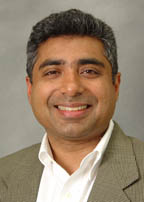Professor's research breaks traditional boundaries of Mechanical Engineering
 Introducing Dr. Arvind Raman:
Introducing Dr. Arvind Raman:
Arvind Raman is a Professor in the School of Mechanical Engineering and at the Birck Nanotechnology Center at Purdue University.
Raman studied at the Indian Institute of Technology Delhi (B.Tech ’91) before coming to Purdue to earn a master’s degree in Mechanical Engineering in 1993. He earned a PhD from the University of California, Berkeley in 1999. He returned to Purdue as an Assistant Professor in 2000.
Dr. Raman’s success as an educator and researcher has earned him many accolades, including a National Science Foundation CAREER award for his research on the nonlinear mechanics and aeroelasticity of gyroscopic systems (2002) and the ASME/PTS Gustus L. Larson Memorial Award (2011), which recognizes outstanding achievement in mechanical engineering. Raman also received a Purdue Teaching for Tomorrow Fellowship Award (2003), the Discovery in Mechanical Engineering Award (2003) for his work on scanning probe microscopy, and the College of Engineering Outstanding Young Researcher Excellence Award (2005).
Interview with Dr. Arvind Raman:
What advancements in technology do you foresee within the next year?
It’s hard to predict but I do have my own wish list. I am fascinated by the possibility of cyberinfrastructure, which is like supercomputing for the masses. I hope that technology will arise that will allow for the daily use of cyberinfrastructure to improve classroom teaching—to change the concept of the classroom—and to significantly reduce the cost of a college education by allowing teachers to teach a larger number of students without sacrificing the personal aspects of teaching.
I am also fascinated by engineering and technology in medicine. I hope to see engineers lead the way in developing new technologies that will enable early diagnosis, control, and treatment of disease – neuromuscular diseases such as Parkinson’s, cardiovascular disease, cancer, and diabetes.
Finally, while I don't personally work in the area, I often imagine engineers coming up with great technologies to prevent damage from natural disasters. Can new technologies prevent tsunami damage to vulnerable coastal populations? Can technology tap into the ability of animals to sense earthquakes before they actually happen? Can we change the path of a tornado so as to prevent damage to a vulnerable population center?
What do you consider to be your greatest achievement as an educator?
Having the honor to mentor young talented researchers toward their PhD’s. I am also proud of the advances the group has made in the field of nanomechanics and atomic force microscopy, an area dominated by physicists, where we have had to work hard to show the important role of mechanical engineers.
What topics are you currently researching?
I am working to make the atomic force microscope into a tool to understand the mechanobiology of disease and to explore the mechanical influence of drugs on cells and viruses. I am using concepts of nonlinear dynamics to improve the atomic force microscope in order to study new materials for energy storage and conversion.
I am also working to create devices to help balance compromised populations such as the elderly, those suffering from Parkinson’s or other neuromuscular diseases, diabetic patients, veterans and injured soldiers.
How do you balance this ambitious approach of researching multiple topics?
The key is to have common binding themes in all research topics and also in teaching. In my case, it’s about dynamics and mechanics, which ties together everything the group does and everything I teach.
What exciting and innovative technologies are you using to conduct your research?
The cyberinfrastructure of the nanohub, which can be used for teaching and researching atomic force microscopy and nanomechanics, and mechatronic interfaces with humans.
What will be some of the applications of your current research on nonlinear dynamics?
I am excited by the work the group is doing with liquids. One key outcome I hope will be that the atomic force microscope will become used more often in clinical settings as a standard test for cancer. Today, everything is based on chemical markers, but mechanical properties also offer insight.
I hope that the tools we have developed for studying viruses can be used to understand new aspects of how anti-viral drugs disrupt the activity of viruses. I am also hopeful that the work we do on liquid-solid interfaces can help develop new technologies for desalination and water purification.
How will your research contribute to the innovative technologies of the future?
I hope that we can contribute in some way towards making the measurement of mechanical properties of live cells a standard clinical test. I hope that the collaboration with health and kinesiology will lead to new devices for helping the elderly and Parkinson’s patients regain upright stability.
